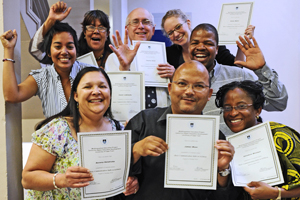isiXhosa course in demand
15 December 2010 Linguists: Prof Mbulungeni Madiba (middle, right) celebrates with (from left, back) Charmaine Buys, Charles Slater and Emma Makin; (middle) Caren Lodewyks; and (from left, front) Rovena Hendricks, James Moos and Abimbola Windapo, who completed the Masithethe isiXhosa course.
Linguists: Prof Mbulungeni Madiba (middle, right) celebrates with (from left, back) Charmaine Buys, Charles Slater and Emma Makin; (middle) Caren Lodewyks; and (from left, front) Rovena Hendricks, James Moos and Abimbola Windapo, who completed the Masithethe isiXhosa course.
The opportunity to learn about the lives and culture of the Xhosa-speaking people and learn to speak basic isiXhosa has attracted over 1 000 UCT staff and students to the Masithethe isiXhosa course over the past four years.
This represents a notable achievement, especially as it is in line with UCT's goal of changing its institutional climate, making the campus more accessible to all people, said deputy vice-chancellor Professor Thandabantu Nhlapo at the recent graduation of the 2010 class.
Offered by the Multilingualism Education Project (MEP) in the Centre for Higher Education Development, and funded by the South Africa-Norway Tertiary Education Development programme, the course was piloted in 2006 to staff, and to students two years later.
Since then 758 staff and 350 students have participated in the programme. In 2010, the MEP (in collaboration with the School of Languages and Literatures) also piloted the isiXhosa in Law course for law students.
Nhlapo urged project managers to monitor the need for a similar course in Afrikaans, the third official language spoken in the Western Cape.
Project co-ordinator Associate Professor Mbulungeni Madiba said many participants noted in their evaluations that they had enrolled on the course for social purposes, to be able to break the ice with isiXhosa speakers, and to increase their 'cultural capital'.
"Learning any language helps one to understand those who speak it a little more, and in this way one benefits from seeing things from other people's points of view," Madiba added.
(Interested in joining the next course? Contact Nonkululeko Nokhepheyi, on 021 650 5359.)
 This work is licensed under a Creative Commons Attribution-NoDerivatives 4.0 International License.
This work is licensed under a Creative Commons Attribution-NoDerivatives 4.0 International License.
Please view the republishing articles page for more information.










